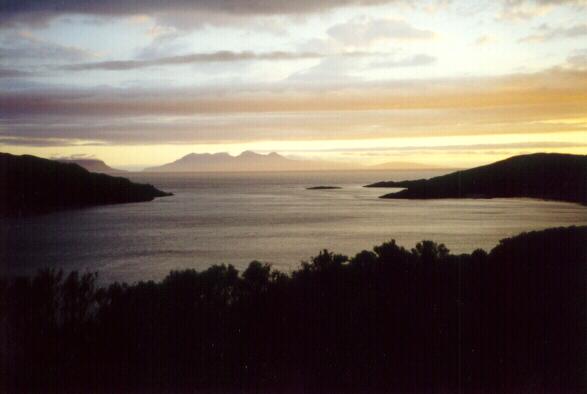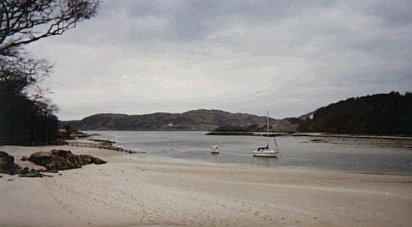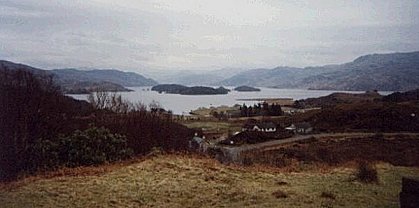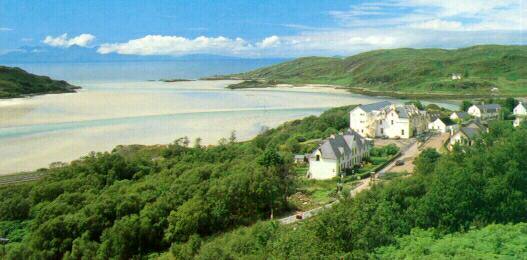Following Bax to Morar by Ian Lace
Following Bax to Morar
by Ian Lace
THE SIR ARNOLD BAX WEB SITE
Last Modified September 17, 2002

The islands of Eigg and Rhum as seen from the Morar Coast.
Photo by Richard Adams
Note: The following article is Ian Lace’s account of his visit to Morar, Scotland where Arnold Bax visited habitually to compose and enjoy the extraordinary scenery. I greatly appreciate Ian for making his article available to me. Ian wants to credit Lewis Foreman whose book, Bax, A Composer and his times, he quotes within the text.
I walked the 2 miles or so between Mallaig and Morar, southwards along the road back to Fort William on the morning of the final day of winter. Over my left shoulder a weak sun tried to nudge its way through darkening clouds and on my right the Atlantic lay grey and still. The epilogue of Bax’s Third Symphony echoed through my mind as I looked across at the islands of Eigg and Rhum (the former flat-topped, the latter mountainous). Both were clearly visible – seemingly almost close enough to touch. “It’ll be sure to rain, then, if you can see them that close,” I had been told cheerily. Certainly, the light levels were inhibiting my photography so I made a mental note to return later in the day if the weather improved.
I had arrived in Mallaig in darkness shortly before midnight, the night before, leaving home about 7:30 that morning. My home is in Steyning, West Sussex, less than ten miles away from Storrington and “The White Horse”, the pub where Arnold Bax lived during the last thirteen years of his life. I traveled to Morar and Mallaig, as Bax had habitually done before me, by train. I started my journey from Brighton catching the 8:01 Thameslink to London Kings Cross and transferred to Euston for the 10:40 express to Glasgow Central arriving at 15:48 in time for a meal and a little sight-seeing before catching the 18:12 for Mallaig. On the way up, when darkness gathered as we reached Dumbarton, I read, once again, about Bax’s experiences at Morar, in Lewis Foreman’s book, Bax, A Composer and his times:
“The Third Symphony was conceived during the autumn of 1928, and was completed in February 1929, probably in Morar, Inverness-shire. That winter was the first one in which Bax went to Morar to work at his music free from all distractions….this first trip to Morar and nearby Arisaig – was made alone. The following winter of 1929-30 he went there only briefly if at all. It was not until the autumn of 1930 that he started making a regular annual pilgrimage to the west coast of Scotland in winter-time, taking the train on the wild west-coast line. But henceforth, for the remaining years of peace, Bax always went to Morar, taking Mary Gleaves with him, to relax and to score his works away from all social and professional demands and obligations. (Harriet Cohen remained Bax s companion on public and musical occasions, and she remained unaware of Mary s existence until 1948).

“So, in the winter of 1928-29, Bax quietly faded from the London scene, and established himself at the Station Hotel, Morar [proprietors in those days – the McKellaig family, admirers of his music to such an extent that they presented him with a half bottle of champagne!] and there, according to Patrick Hadley writing Bax’s obituary tribute in Music and Letters, sometimes in polar conditions, in a dingy unheated room, working in an overcoat, he proceeded to set out the sketch he had previously written with constant resource to the keyboard at his Hampstead lodgings. “It was wonderful in the north in spite of a mantle of cloud all the time, Bax reported on one occasion, only two sunny days in three weeks.’
“The Fourth Symphony, one that reflects Bax’s happiness and fulfillment was written between October 1930 and February 1931, almost entirely at Morar, although part of the first movement, at any rate was worked out at Glencolumcille. (Bax continued to go his other favourite sanctuary, Glencolumcille, in north west Ireland, until at least 1934 but 1930 really marked the break with his habit of spending long periods there.) The work has a markedly different personality from the three earlier symphonies; perhaps Bax realized this and felt that it required explanation. In fact for the only time in the symphonies, he publicly admitted that the beginning of the first movement meant to him a rough sea at flood-tide on a sunny day, and most of the work is nature music.”
Work on the Fifth, Sixth and Seventh symphonies also proceeded at Morar as did work on the Violin and Cello concertos plus the Second Northern Ballad. Foreman writes about snowy landscapes, stormy seas and the view of the islands all inspiring these works. In his last year at Morar, 1940, Bax was more concerned with writing Farewell, My Youth, his autobiography covering the events of his life up to the outbreak of the First World War. [Bax was a kindly man and he shrank from the thought of upsetting anybody with anything he wrote however inadvertently.]
Now, I was on my way to Morar eager to see the place that had inspired so much music. The road turned suddenly and descended slightly; a small bay came into view with grotesque-shaped rocks on the beach, close to the road, that looked almost like troglodytes. The water here was pure and transparent and shoaled in patches of brilliant aquamarine and dark blue. The road then turned from the sea and rose steeply. From the top of the hill as the road turned again, I caught my first glimpse of Morar below. I was surprised to see how small it was: a few houses, no shops just a BP service station selling sweets and chocolate, the railway station and the Morar Hotel (known as the Station Hotel in Bax s days). The Hotel was immediately visible from my vantage point; indeed it dominated the skyline dramatically; a large white building set at the top of another steep hill and framed by dark blue mountains that seemed to rise sheer behind it.
My first impression, as I approached the Hotel, was how much the exterior reminded me of “The White Horse” at Storrington. Then I noticed how close it was to the railway, literally just across the road. I entered the Hotel only to find that it was officially closed. All the staff were scurrying around busily preparing for the opening of the new season the following Easter weekend. Nevertheless, I was greeted by the proprietor, Mr A.J. MacLeod, who showed me the plaque which he hangs in the lounge at the front of the Hotel. The ground floor has an open plan design; the lounge area opening out from the reception desk. On the walls are pictures of the Hotel with the steam trains that ran along the “Iron Road to the Isles,” and still do occasionally in the holiday season. I was shown upstairs to back bedroom No 11 which was occupied by Bax every winter from 1928 to 1940. In those days it looked directly over the Atlantic. (A large new two-story extension to the Hotel has now completely blocked the view). In Bax’s day though, in this room, from his elevated position, he could enjoy a splendid vista, looking over the white sands of an almost-enclosed bay out to the Atlantic towards Rhum and Eigg. One can imagine Bax sitting there hour after hour watching the sea in all its moods, still and shining under a frosty full moon or surging tumultuously in a full force gale. (The seas around here can be extremely treacherous. The walls of the guest house at Mallaig where I stayed were covered with testimonials to the heroism of the coxswain and his crew of the open Mallaig lifeboat of the 1950s when the crew had to battle through mountainous seas to rescue imperiled sailors.)
From the hotel I walked the few yards across the railway track and climbed a steep hill that was surmounted by a large iron cross. From its top there were spectacular views all around. You look down on the Hotel to the right and straight ahead out to sea. Behind is Loch Morar thought to be even deeper than Loch Ness. It has its own sea monster, known affectionately as Morag! Ghostly fingers of mist were creeping down the mountains that framed the Loch as I looked down on it. The few tall gaunt pines on the islets that studded it looked forbidding and spectral. This, I imagine would be just the sort of landscape to inspire some of Bax’s more horrific pages. Bax spent much time in contemplation of this scenery. His favourite walk was by the side of the Loch “to the music of the water and the wind in the trees” – as he once remarked to his host.
Descending again to the road, I walked first to the head of the Loch to see the River Morar, the shortest river in Great Britain, wend down to the sea and then to the beach to marvel at the expanse of clean white sand and, again, the amazingly rich colours of the waters. I was told that the sunsets here are absolutely glorious but on this occasion I was to be disappointed for it began to drizzle so I hastened for the 1:10 train back to Mallaig.
Mallaig, itself, is a very attractive and picturesque fishing village. It has a large harbour which is the embarkation point for the ferry to the Isle of Skye.
The people here are warm and friendly. When the proprietor of the Western Isles Guest House,East Bay, Mallaig, where I stayed, learned that the weather had not allowed me to take photographs, she insisted on having her daughter run me back to Morar the following morning for another attempt before my train left for home at 10:30 from Mallaig. Alas the light levels were much the same but she did introduce me to some more lovely corners of Morar that I had overlooked the day previously.

Interestingly, my hosts in Mallaig told me that their locale was sheltered from the worst of the winter and that snow was not frequent and did not lay very long except on the mountain tops. The guide books also confirm that this area of Scotland has a fairly mild climate due to the effects of the gulf stream although there are some pretty stiff gales and the consequent chill factor would therefore make winter living uncomfortable. However considering that the McKellaigs welcomed Bax every year and presumably made him comfortable, I wonder whether the stories of intense cold and Bax shivering up there were really rather exaggerated to keep people at bay and preserve his peace and privacy? (On the other hand, Lewis Foreman told me that he remembered shivering himself when he visited Morar and Arisaig some twenty years ago.) Another thought: we are often told about Bax’s Peter Pan attitude and his wanting to get away from it all. Given that Bax was a dreamer and a self-confessed brazen romantic, maybe there was also a certain calculated practicality in his make-up too, for him to chose Morar? After all, it might have occurred to him to go on to Skye – an even more romantic environment. But no, he decided to stay just across the road from a railway station allowing him a reasonably easy escape route to London if business or any other crisis beckoned him.
Of course, it probably was not all work and no play at Morar, and Bax will have traveled through Scotland widening his inspiration. There is a clue in a letter he wrote to Mary Gleaves, at the time he was writing The Tale the Pine-Trees Knew, in which he says: …the pine trees in Rothemurchus sighed and sighed and I longed for you to be with me.” Now Rothemurchus is situated well to the east of Morar near the Cairngorm Mountains and much closer to Aberdeen than Morar.
Although my researches at Morar were complete, there still remained one of the high points of my adventure – the rail journey back to Glasgow, this time in daylight, along the “Iron Road to the Isles” to Fort William and past snow-capped Ben Nevis and its neighbouring high peaks, over the wild and desolate Rannoch Moor and down to Loch Lomond. I have never been so impressed with a rail journey. The views, particularly between Mallaig and Fort William, are truly magnificent and I was lucky that it was cloudy-bright so that the landscapes looked intensely dramatic. For five hours my eyes were riveted to the train windows.
Little wonder that Bax was drawn to this corner of Scotland. Remote, romantic unspoiled then and little changed now. As I journeyed south along the alternative route to Kings Cross through Northumbria, I remembered something else Lewis Foremen had written – “We may imagine Bax gazing at the snowy landscape near Morar, still dreaming his indomitable dream of Tir na nOg across the icy waves, beyond the blue-grey shapes of the islands; the bronze winter sun and the purple-grey clouds marking the distant land of eternal youth which he had once glimpsed but never could attain.”
Some facts and figures:
Travel:
Trains run from Glasgow Queen Street to Mallaig three times per day at 8:12 am arriving at 13:20; at 12:42 arriving at 17:49 and at 18:12 arriving at 23:30.
Trains return from Mallaig to Glasgow at 06:00 arriving at 11:14; at 10:30 arriving at 15:44, and at 16:10 arriving at 21:14.
(The above times were operational as of March 1997, travelers are advised to contact British Rail to ensure they are still current.)
Alternatively, a sleeper service operates between London Euston to Glasgow Central departing at 23:55 and arriving at 06:40 in time for breakfast and transfer to Glasgow Queen Street for the 8:12 train arriving at Mallaig at 13:20.
Accommodation at Hotel Morar:
Hotel Morar – 26 to 35 pounds per person B&B according to the season
Tel: (0)1687 462346; Fax: (0)1687 462212
Suggested alternative accommodation at Mallaig:
Marine Hotel (adjacent to Mallaig Station): B&B single – 25-35 pounds; DB&B- 43-48 pounds
Tel: (0)1687 462217; Fax: (0)1687 462821
Western Isles Guest House (Mrs Watt): B&B single 16-18 pounds twin/double 15- 16 pounds
DB&B 25 -27 pounds
Tel/Fax: (0)1687 462320

The Morar Hotel (known as the Station Hotel when Bax stayed there in the 1930s)
Photo by A.G. Macleod
The following summary appears in a frame at the Morar Hotel:
“SIR ARNOLD BAX, the English composer and Master of the King s Music, was a frequent guest at this hotel between 1928 and 1940. “Born in 1883, Bax studied composition at the Royal Academy of Music. At the age of 18 he discovered the poetry of W.B. Yeats, which inspired a life-long devotion to the Celtic world. His most famous work, the tone-poem Tintagel, was written in 1917, and during the inter-war years he was recognized as one of the most distinguished composers of his generation. “Bax first came to this hotel (then called the Station Hotel) in the winter of 1928-9, and it was here, during long visits over the next ten years, that he orchestrated some of his finest works, including the last five of his seven symphonies and concertos for cello and violin, as well as descriptive pieces based on Gaelic subjects, such as the First Northern Ballad (a musical impression of Highland life before the Jacobite Rising of 1745). “Bax was knighted in 1937, and early in 1940, during his last stay here, he wrote his autobiographical volume Farewell, My Youth. For the final thirteen years of his life he lived at the White Horse Inn at Storrington in Sussex. In 1942 he was appointed Master of the King s Music, and his last orchestral score was a march written for the coronation of Elizabeth II in June 1953. Four months later, at the age of 69, he died on a visit to Cork. “Arnold Bax loved the west coasts of Ireland and Scotland passionately, and the beautiful scenery of Morar and the rugged Highland landscape had a deep spiritual influence on his music.”
The text is copyrighted by Ian Lace
